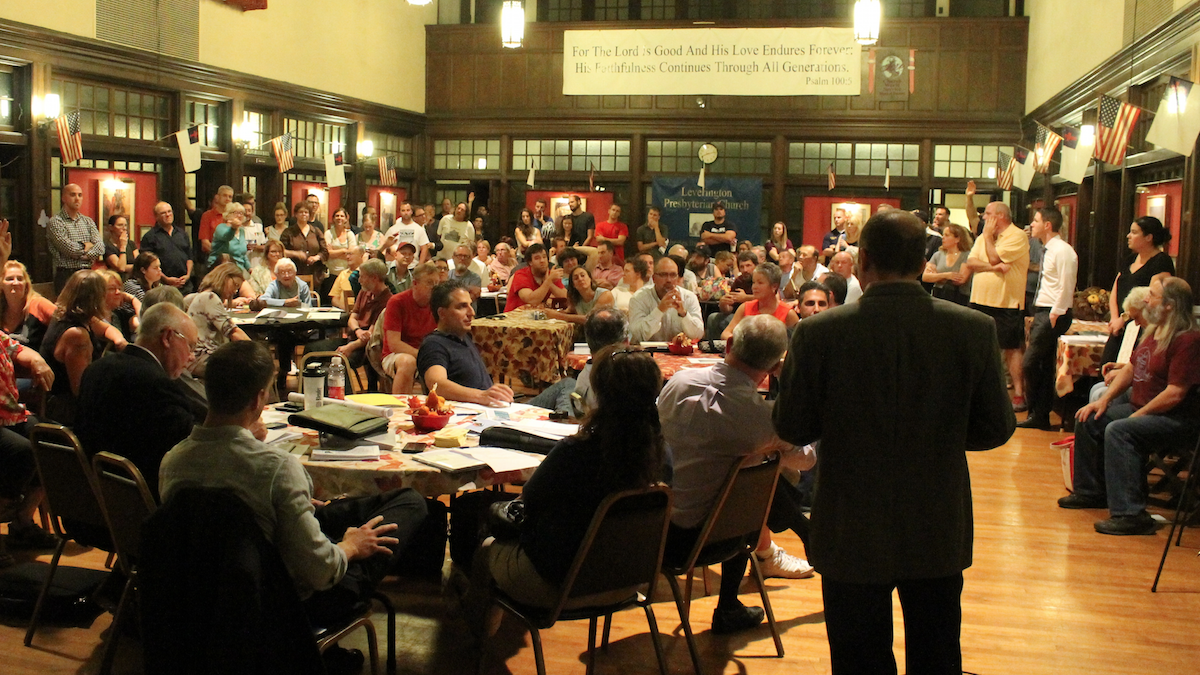Rare neighborhood-development overlay proposed for Roxborough

The effort to create the Central Roxborough Neighborhood Conservation Overlay was sparked by the community's involvement surrounding the Bunting House demolition issue. (NewsWorks, file art)
Legislation that would make Central Roxborough just the second neighborhood in Philadelphia to have regulations protecting its small-town character will be introduced in City Council on Dec. 2.
While not as restrictive as a historic-district designation, the Central Roxborough Neighborhood Conservation Overlay would ensure that developers maintain the “human-scaled design, interesting and pedestrian friendly facades” through rules related to building setbacks, height, construction materials and parking.
The ordinance is expected to be presented to the City Planning Commission on Tuesday, and then go to Council’s Rules Committee in December, when the public is invited to attend and testify.
Could the regulations in the NCO deter some developers from considering projects in the Central Roxborough neighborhood?
“Well, I hope so,” said Fourth District Councilman Curtis Jones Jr. “We don’t just need any [developer] anymore. We need the right developers who understand the character of a neighborhood.”
Start of a movement
The effort to create an NCO in Roxborough was sparked by the demolition in Dec. 2012 of the Bunting House, a handsome, late 19th-century stone house on the 5900 block of Ridge Ave.
A group of Roxborough residents, who had been opposed to the razing of the Victorian structure for a planned fast-food restaurant, asked the Planning Commission what could be done to have more control over redevelopment in the community.
“The first thing we did was zoning remapping,” said Kay Sykora, one of the concerned residents. “Next, we began work on the Neighborhood Conservation Overlay, and that took a year.
“We had to photograph every property in the district. Then, we debated the ordinance — it was a community process. We had to make sure people were heard, and they responded in a very positive way to it.”
Sykora, a former leader of the Manayunk Development Corporation, said she is not against new construction.
“But, what’s happening right now in Roxborough — and citywide — is that it’s easier for developers to just come in and drop stuff and build,” she said. “They’re taking down the older buildings” and replacing them with rows of new houses that are “often not in character with the community.”
The NCO is “an effort in older sections to preserve the character of the area,” according to Sykora.
“This adds another step to folks wanting to do new construction,” Sykora said, “but the goal is to preserve and enhance what’s there.”
Getting down to specifics
The proposed ordinance for Central Roxborough focuses mainly on residential properties on blocks selected for their “historic pattern.”
It calls for new building designs that are consistent with the “massing, vertical and horizontal articulation, fenestration proportions and building materials” of the existing homes.
The front setback of the new construction must be no further back than the setback of the next-door lots.
If one of the neighboring buildings is no more than two stories, the stories on the new building above that height must be set back an additional eight feet.
Porches are required on the new buildings if one of the neighboring buildings has one.
Aesthetic concerns are included: Utility meters and other equipment on the front of new buildings must be screened with landscaping, fences or walls. Environmental issues are also addressed: impervious surfaces of front yards can’t exceed 30 percent.
The ordinance also prohibits use of vinyl or aluminum siding or synthetic stucco on the façade of new construction. Chain-link and vinyl fences are also forbidden on the front of new properties.
Parking is another important issue in the ordinance. Front-yard parking and front-loaded garages are not allowed. Curbcuts are limited to 12 feet in width.
Shopfronts are subject to rules in the ordinance, as well. They must have at least 50 percent clear glass on the façade, and awnings must be at least three-feet deep.
According to the ordinance (PDF), the Central Roxborough/NCO applies to properties in “the area generally bounded by Gates Street (both sides), Ridge Avenue, Hermitage Street, Manayunk Avenue (both sides), Green Lane (both sides), Dexter Street (both sides), Lyceum Avenue, Manayunk Avenue (both sides), Roxborough Avenue (both sides), Ridge Avenue, Dupont Street (both sides), Lawnton Street, Green Lane, Jannette Street, Monastery Avenue and Henry Avenue.”
Why Roxborough?
The only other NCO in the city was created for Queen Village, according to Josh Cohen, special assistant to Councilman Jones.
“I’ve heard that it’s much more restrictive” than the legislation proposed for Central Roxborough, said Cohen.
Jones describes his district as unique neighborhoods or “small towns” of distinctive structures and landscapes. East Falls and Manayunk were the first to enjoy prosperity but have bccome almost “over-saturated” by development and subdivision.
“Now, developers and the public at large have discovered Roxborough. It’s no longer a secret,” said Jones. “It was a bedroom community that is still in the city, but was as country as you can get,” with livestock and crops still raised in Andorra and on W.B. Saul High School’s rolling farmland.
Roxborough offers great value to developers and young people “who want to raise their children in an area that still has a Main Street, which in our case is Ridge Avenue,” he said. With that demand comes “unintended consequences, like the razing of the Bunting House. So, you have beautiful Victorian homes that are irreplaceable being mowed over for a Wendy’s takeout window.”
What spurred its creation
The Bunting House was “one of the galvanizing flash points,” Jones said.
“Every neighborhood has at least one house they’re wrestling with over developers’ expectations,” he continued. “So, you have to use a delicate balance of being able to add amenities, but not take away from the character of the small town. This overlay helps to do that.”
Other communities in his district are seeking “another extreme” historic certification to protect the existing buildings and character of the neighborhoods, Jones said, but “I don’t want to go to that level [in Roxborough], because that affects almost any renovation by a homeowner.
“But, I should not see aluminum siding, quick fixes and cheap fixes where people have spent time, attention and money to maintain the character of their neighborhood.”
When he first joined City Council seven years ago, “I was thinking all development was good. Well, no, it isn’t,” Jones said.
He has heard that some developers are “quietly concerned” about the regulations in the NCO, “but it makes them change their thinking about what should be appropriate development for that area. There are parts of the city where any development is welcomed. But that’s not every part of the city.”
Cohen said they do not expect opposition in Council to the ordinance for Central Roxborough, and passage could come before the December break.
It could then reach the Mayor’s desk for signage into law early next year.
NewsWorks has partnered with independent news gatherer PlanPhilly to provide regular, in-depth, timely coverage of planning, zoning and development news. Contact Alan Jaffe at ajaffe@planphilly.com.
WHYY is your source for fact-based, in-depth journalism and information. As a nonprofit organization, we rely on financial support from readers like you. Please give today.






